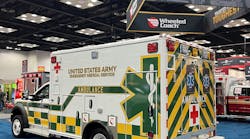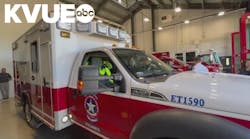Resources for fire, EMS and hazardous materials responses in rural areas often are limited by community size, personnel availability and distances between communities. Hazmat response, being a much more specialized resource in terms of amounts of training required and equipment necessary to handle an incident, are much more limited in many cases in rural areas than fire and EMS resources.
Hazardous materials exposures, on the other hand, are not limited. In fact, hazardous chemicals may be present in much greater quantities in rural areas than in many larger communities with adequate response resources. Even the smallest rural communities may have exposures from agricultural pesticides, anhydrous ammonia, propane, petroleum products and other hazardous materials. Ethanol manufacturing plants are springing up across the country in rural areas, creating large volumes of flammable ethanol in fixed storage and rail transportation, in particular.
Throughout the state, there are 12 hazardous materials teams from paid departments that can be activated by the Nebraska Emergency Management Agency (www.nema.ne.gov). At such times, teams are placed on the state payroll to respond to incidents anywhere in Nebraska, including rural areas. This column is about one of those teams, in Grand Island.
Despite the name, Grand Island is not surrounded by water. Rather, it is in central Nebraska, about 74 miles from the geographical center of the state and 77 miles from the geographical center of the lower 48 states. Grand Island has a population of 48,500 and covers 27 square miles. In 2010, the Nebraska State Fair was moved from Lincoln to Fonner Park, a horse-racing track and casino in Grand Island, so the community’s population can easily soar above 100,000 during the fair and other events. Grand Island is also the county seat for Hall County and home to the Stuhr Museum of the Prairie Pioneer, Heartland Events Center and Nebraska Danger Arena Football team. Grand Island also hosts many agricultural and livestock events, including Husker Harvest Days.
Volunteer fire protection in Grand Island was organized in 1874 with the first fire company, followed several months later by the first ladder company. By 1876, membership grew to 25. In 1908, equipment consisted of hand-drawn hose carts, a ladder wagon and a hand-operated pump that took water from cisterns. In 1909, the first horse-drawn mechanical truck was purchased. The first motorized fire apparatus, a chemical hose truck, was purchased in 1913 for $4,150. Volunteers staffed the Grand Island Fire Department until 1921, when the department became fully paid. Today’s Grand Island Fire Department is led by Chief Troy Hughes and staffed by 68 uniformed personnel. Grand Island firefighters operate from four stations, using four engines, a truck, a heavy rescue, three medic units and a hazardous materials trailer. The department responded to 4,355 calls for service in 2010. Of those, 3,674 were EMS, 625 were fires and 56 were hazmat responses, including fuel spills, gas odors and leaks.
Grand Island formed its Hazardous Materials Response Team in 1985. The team’s first response vehicle was a converted United Parcel Service delivery van that was donated to the fire department. The primary response area is Hall County plus approximately 800 square miles through mutual aid agreements with area fire departments. Additionally, the team may be activated by the state Emergency Management Agency and respond as needed.
Following the 9/11 terrorist attacks, Grand Island’s team became a part of the State of Nebraska response team. When called on for a state activation, the team may page additional off-duty technicians to assist in the response. Grand Island’s team is not dedicated and personnel from Engine 4 and Medic 4 staff the response trailer when a hazmat incident occurs. Three to five hazmat technicians are on duty each shift and additional personnel are called back to duty when necessary.
Currently, there are 34 trained hazmat technicians on the fire department. Grand Island is working toward training all uniformed personnel to the technician level. For now, firefighters and medics not trained to the technician level are trained to the operations level. Personnel are also trained to conduct decontamination to free technicians for mitigation duties. Technician-level training is done through the Nebraska Emergency Management Agency’s 80-hour course. Every two years, team members take a 40-hour refresher. Additional specialized training is obtained through the Center for Domestic Preparedness in Anniston, AL, for chemical and biological terrorist agents and in Pueblo, CO, for railcar incident training.
In addition to the Engine 4 and Medic 4 personnel, a hazmat response in Grand Island’s primary response area brings the shift captain, battalion chief and the engine and medic unit in the district where the incident occurs. If mutual aid is required, the Hastings Fire Department Hazmat Team is 23 miles to the south and Columbus Fire Department is 60 miles to the northeast. Grand Island also works and trains with the 72nd Civil Support Team of the Nebraska National Guard in Lincoln, 100 miles away.
Grand Island’s current hazmat response vehicle is a 24-foot Wells Cargo trailer pulled by a 2003 Ford F350 pickup truck. The unit is housed in its own building behind Fire Station 4 on Grand Island’s west side. Engine companies carry absorbent materials for cleaning up fuel and oil spills. The hazmat team is called in as needed to assist. All hospitals in Nebraska have decontamination capabilities with coordination through the Nebraska Emergency Management Agency and the University of Nebraska Medical Center.
In the building where the hazmat trailer is housed monitoring and detection equipment is calibrated and stored along with other equipment until needed for a response. Monitoring and detection equipment carried by the Grand Island hazmat team includes Chemical Agent Test Kits, photo ionization detector, TMX-412 multi-gas detectors, APD 2000 chemical warfare agent detector, radiological emergency response kits, Biowarfare Agent Detection Devices (BADD) kit, Hazmat ID and Haz Kat. The Nebraska Department of Health provides sampling kits to the state’s hazmat teams. These kits provide equipment and supplies to gather samples of weapons of mass destruction (WMD) to be analyzed at the state labs. Each team member has a personal protective equipment (PPE) bag with gloves, boots and coveralls to be used during an incident. Equipment is loaded on the response trailer based on the personnel responding and the anticipated type of hazardous materials involved. Personnel are developing a tag system to place on certain types of equipment to indicate what equipment is taken on a specific type of response. Level A and B protection is provided by DuPont Tychem with flash protection for working around flammable materials. Breathing apparatus used is Scott self-contained breathing apparatus (SCBA) with one-hour bottles and positive-pressure air-purifying respirators (PAPRs) for WMD responses. The team also carries3M full-face respirators with organic vapor, acid gas, ammonia methylamine and multi gas cartridges. Insuit communications is provided by Kappler headsets that are used with normal radio communications equipment. Reference materials include Emergency Handling of Hazardous Materials, Union Pacific Guide to Tank Cars, Tyvek Protective Apparel User Manuals, Hawley’s Condensed Chemical Dictionary, NIOSH Pocket Guide to Hazmat Emergency Responses, Sax’s Dangerous Properties of Industrial Chemicals, DOT Emergency Response Guide Books, Merck Index, CHRIS Manuals and Hazardous Chemicals Desk Reference and CHEMTEC CMA User’s Guide for Emergency Responses.
During incident responses, Grand Island Hazmat Team members use incident forms for various positions in the Hazmat Incident Command structure. Using the prepared forms simplifies recording information, tracking personnel, gathering needed information, developing required site safety plans and managing the incident scene. Forms are used for the incident commander, safety officer, entry group supervisor and hazmat operations branch officer. The team has developed a Mutual Aid Link-Up Questionnaire to document information about an incident before and during responses to scenes that in some cases may take long periods. Gathering predetermined types of information before arriving on scene saves time and lets the members prepare for what they may be dealing with once on scene. The form contains three major headings, Dispatch Information, On Scene Information and Post-Incident Information, that help members write after-action reports and return equipment and supplies to service.
Major hazmat transportation exposures are Interstate 80, U.S. Highway 281, Nebraska Highway 2, and the Union Pacific and Burlington Northern Santa Fe railroads. No major pipelines are present in the primary response territory. Chemicals transported through Grand Island are many and varied in nature. They include anhydrous ammonia, propane, chlorine and pesticides. Fixed-facility exposures include the Case-New Holland manufacturing plant, Chief Industries, Swift Meat Packing facility and McCain Foods processing center.
Grand Island’s hazmat team has responded to several major incidents in recent years, including a chlorine emergency at the YMCA, a chemical fire at a foundry in Hastings, an ethanol spill involving a railcar in Wood River, chlorine at a water treatment plant and a gasoline spill at an ethanol plant. The team also is called on periodically to assist law enforcement in the evaluation and cleanup of illegal methamphetamine labs.
• • •
For additional information, contact Training Division Chief Tim Hiemer at 308-385-5311 or [email protected].






